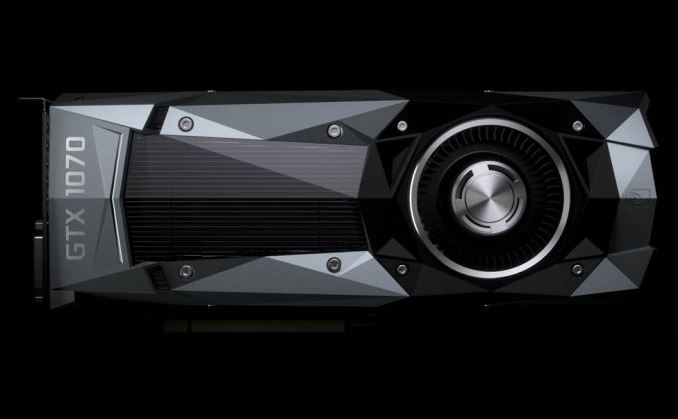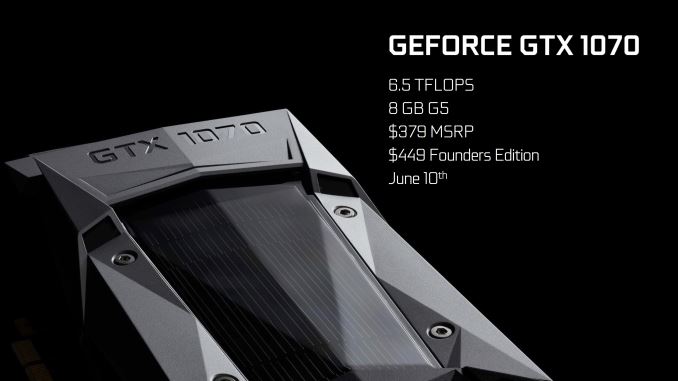NVIDIA Posts Full GeForce GTX 1070 Specifications: 1920 CUDA Cores Boosting to 1.68GHz
by Ryan Smith on May 18, 2016 10:15 PM EST
Back when NVIDIA first announced the GeForce GTX 1080 earlier this month, they also briefly announced that the GTX 1070 would be following it. The GTX 1070 would follow the GTX 1080 by two weeks, and presumably to keep attention focused on the GTX 1080 at first, NVIDIA did not initially reveal the full specifications for the card. Now with the GTX 1080 performance embargo behind them – though cards don’t go on sale for another week and a half – NVIDIA has posted the full GTX 1070 specifications over on GeForce.com.
| NVIDIA GPU Specification Comparison | ||||||
| GTX 1080 | GTX 1070 | GTX 970 | GTX 770 | |||
| CUDA Cores | 2560 | 1920 | 1664 | 1536 | ||
| Texture Units | 160 | 120 | 104 | 128 | ||
| ROPs | 64 | 64 | 56 | 32 | ||
| Core Clock | 1607MHz | 1506MHz | 1050MHz | 1046MHz | ||
| Boost Clock | 1733MHz | 1683MHz | 1178MHz | 1085MHz | ||
| TFLOPs (FMA) | 8.9 TFLOPs | 6.5 TFLOPs | 3.9 TFLOPs | 3.3 TFLOPs | ||
| Memory Clock | 10Gbps GDDR5X | 8Gbps GDDR5 | 7Gbps GDDR5 | 7Gbps GDDR5 | ||
| Memory Bus Width | 256-bit | 256-bit | 256-bit | 256-bit | ||
| VRAM | 8GB | 8GB | 4GB | 2GB | ||
| FP64 | 1/32 | 1/32 | 1/32 | 1/24 | ||
| TDP | 180W | 150W | 145W | 230W | ||
| GPU | GP104 | GP104 | GM204 | GK104 | ||
| Transistor Count | 7.2B | 7.2B | 5.2B | 3.5B | ||
| Manufacturing Process | TSMC 16nm | TSMC 16nm | TSMC 28nm | TSMC 28nm | ||
| Launch Date | 05/27/2016 | 06/10/2016 | 09/18/14 | 05/30/13 | ||
| Launch Price | MSRP: $599 Founders $699 |
MSRP: $379 Founders $449 |
$329 | $399 | ||
Previously disclosed at 6.5 TFLOPs of compute performance, we now know how NVIDIA is getting there. 15 of 20 SMs will be enabled on this part, representing 1920 CUDA cores. Clockspeeds are also slightly lower than GTX 1080, coming in at 1506MHz for the base clock and 1683MHz for the boost clock. Overall this puts GTX 1070’s rated shader/texture/geometry performance at 73% that of GTX 1080’s, and is a bit wider of a gap than it was for the comparable GTX 900 series cards.
However on the memory and ROP side of matters, the two cards will be much closer. The GTX 1070 is not shipping with any ROPs or memory controller channels disabled – GTX 970 style or otherwise – and as a result it retains GP104’s full 64 ROP backend. Overall memory bandwidth is 20% lower, however, as the GDDR5X of GTX 1080 has been replaced with standard GDDR5. Interestingly though, NVIDIA is using 8Gbps GDDR5 here, a first for any video card. This does keep the gap lower than it otherwise would have been had they used more common memory speeds (e.g. 7Gbps) so it will be interesting to see how well 8Gbps GDDR5 can keep up with the cut-down GTX 1070. 64 ROPs may find it hard to be fed, but there will also be less pressure being put on the memory subsystem by the SMs.
Meanwhile as is usually the case for x70 cards, GTX 1070 will have a lower power draw than its fully enabled sibling, with a shipping TDP of 150W. Notably, the difference between the GTX 1080 and GTX 1070 is larger than it was for the 900 series – where it was 20W – so we’re going to have to see if GTX 1070 ends up being TDP limited more often than GTX 1080 is. In that sense TDP is somewhat arbitrary – its purpose is to set a maximum power consumption for cooling and power delivery purposes – and I’m not surprised that NVIDIA wants to stay at 150W or less for the x70 series after the success that was the GTX 970.
Like the GTX 1080, the GTX 1070 will be launching in two configurations. The base configuration is starts at $379 and will feature (semi) custom partner designs. Meanwhile as previously disclosed, NVIDIA will be offering a Founders Edition version of this card as well. The Founders Edition card will be priced at $449 – a $70 premium – and will be available on day one, whereas this is not guaranteed to be the case for custom cards.
The GTX 1070 Founders Edition card will retain the basic stylings of the GTX 1080, including NVIDIA’s new angular shroud. However I have received confirmation that as this is a lower TDP card, it will not get the GTX 1080’s vapor chamber cooler. Instead it will use an integrated heatpipe cooler similar to what the reference GTX 980 used.











137 Comments
View All Comments
SaolDan - Wednesday, May 18, 2016 - link
Neat!!lazarpandar - Wednesday, May 18, 2016 - link
Even though it's cheaper, it sounds like the Founders Edition is even less important on this card.Kjella - Wednesday, May 18, 2016 - link
The interesting part is just how long nVidia will gouge the market until partner cards at the normal MSRP shows up, if you had day one availability I imagine the Founder cards would be pretty much DOA. Everybody knows graphics card devalue over time though so if it's a Founder card today or a regular card two months from now...Yojimbo - Wednesday, May 18, 2016 - link
Stop misusing that word "gouge". You can post how much you dislike them making early editions of the cards and charging more for them all you want, but don't misuse words just to try to sound as pejorative as possible. Next you're gonna tell us that NVIDIA is literally Hitler.Impulses - Thursday, May 19, 2016 - link
Milk the market is probably the more appropriate slang.dsumanik - Thursday, May 19, 2016 - link
I have to agree with kjella. Nvidia has had 0 competition in this space, their product cycles have slowed dramatically, and the new "founders eidtion' program is quite simply a way to squeeze another 100 bucks out of an already severely overpriced card.In 2016 chips of all sorts should be going down in cost, not up...this is marketing games plain and simple.
If people would all like this behavior to stop from Nvidia, don't purchase the founders edition cards. Every person who makes the overpriced purchase, gets nvidia board of directors salivating over another price increase, even higher for the next round.
jasonelmore - Thursday, May 19, 2016 - link
they spent billions on R&D for pascal. Do you know how many quarters of revenue it will take for nvidia to even break even on R&D? and thats not counting one cent of bill of materials. It will take nvidia over a year to recoup R&DEcdmuppet - Thursday, May 19, 2016 - link
This is exactly correct.Marginal costs for electronics, meaning the cost of the materials for each unit, are laughably small. If they sold the cards at their unit cost, the cards would probably be about $15.
But the cost of developing the chips, the machines to make the chips, the machines to make the cards, and setting up all that infrastructure is astronomical. We are talking about hundreds of millions, or even billions of dollars to set up a fab for cutting edge chips.
What you end up with is the first card that rolls off the line cost a billion and ten dollars to make, and the second card cost ten bucks.
Having early adopters pay more mirrors this phenomenon. It helps the manufacturer recoup some of that money while demand is super high and supply hasn't caught up yet.
Those without the coin to pay the early adopter fee may feel like it favors the rich, but also consider that it means when those wealthier buyers pay extra, it helps the manufacturer take the prices down that much sooner for the rest of us. It's acasually a natural form of progressive taxation that benefits the real-world marketplace. For all the ways Capitalist markets fail society, this is actually an example of how it produces a pretty fair outcome, in my opinion.
Murloc - Thursday, May 19, 2016 - link
exactly, only fools and the very rich will buy the founder's edition, and that's all better for us.If nvidia gets more profits without making us reasonable people pay more, maybe they will price the other cards more aggressively.
bananaforscale - Thursday, May 19, 2016 - link
Or those who want to give nV a bigger slice of the price. There *are* those. Sell direct to consumer and you're cutting at least one step from the supply chain (probably two, since they'd be sending cards to retailers anyway), and those willing to pay more get their cards earlier than those who wait for third parties. It's kinda an early adopter tax, but also goes towards recouping the R&D costs faster, so nV can release the next generation faster if technology allows it.